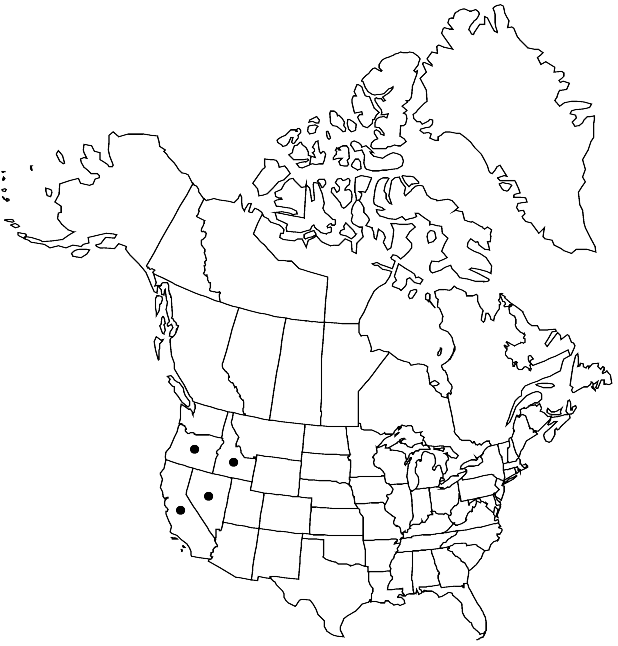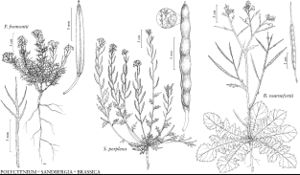Polyctenium fremontii
Leafl. Bot. Observ. Crit. 2: 219. 1912.
Plants with woody base, sparsely to densely pubescent. Stems few to numerous from base, (0.2–) 0.5–1.6 (–2) dm, usually sparsely to densely pubescent proximally, sometimes glaucous and glabrous distally. Cauline leaves often persistent in subsequent seasons as pectinate spines; petiolate proximally, subsessile distally; petiole winged, 0–3 (–5) mm; blade linear (in outline), (0.5–) 1–2.2 (–2.8) cm, rigid, surfaces sparsely to densely pubescent, trichomes dendritic, margin and apex often with simple or forked ones; lobes (2–) 3–4 (–5) each side, with prominent midvein and narrow band of blade; terminal lobe (0.2–) 0.4–0.7 (–1) cm × (0.3–) 0.5–1 (–1.5) mm, as long as or slightly longer than adjacent lateral lobes. Fruiting pedicels (2–) 4–7 (–10) mm, sparsely pubescent or glabrous. Flowers: sepals 1.5–2 × 0.9–1.1 mm, hyaline-margined, glabrous or sparsely pubescent; petals 3–4 × 1.5–2 mm, attenuate to base; filaments 1.2–2 mm; anthers 0.4–0.5 mm. Fruits erect to ascending, (0.2–) 0.4–1.3 (–1.8) cm × 0.9–2 mm; style (0.2–) 0.4–0.7 (–1) mm. Seeds 0.7–0.9 × 0.3–0.5 mm.
Phenology: Flowering late May-early Aug.
Habitat: Mud flats, dry meadows, sagebrush areas, edge of vernal pools, shallow soil on basalt, dry streambeds and swales, gravel bars, rocky wash
Elevation: 1000-2700 m
Distribution

Calif., Idaho, Nev., Oreg.
Discussion
Polyctenium fremontii is highly variable in fruit size and the compactness of the fruiting raceme, but in habit, flower size and color, leaf morphology, indumentum, fruiting pedicel length and orientation, number of ovules per ovary, and basically every other aspect of the plants, it is quite constant. If one examines only the types of those two taxa and that of P. fremontii, it seems that perhaps two or three taxa might be recognized. Upon careful study of extensive material, one realizes that only one taxon, instead of three or more, is represented. The alleged differences between P. fremontii and P. williamsiae in characters other than fruit morphology do not hold. As for fruit size, it was said to be 2–4 × 2–2.5 mm in P. williamsiae and (4–)6–13(–20) × 1–2 mm in P. fremontii. Fruit lengths in material annotated by Rollins as P. fremontii are 2–7 mm in Tiehm 8108 and 3.5–11 mm in Ertter 5726, both at GH. Furthermore, the compactness of the infructescence can be equally variable, and in the holotype of var. confertum there are 12–15 pedicels along 1 cm in the middle of the rachis, whereas in Ertter 5726 (GH) there are 6–12. On one sheet, Schoolcraft 1287 (GH), compact and lax racemes and relatively short (3 mm) and longer (7 mm) fruits are represented. The variation in fruit length and width depends largely upon the number of ovules maturing into seeds, and in plants with very short fruits, including the type collection of P. williamsiae, none of the ovules matured into seeds, whereas in those with longest and narrowest fruits almost all ovules matured into seeds. Regardless of how long the fruit is or how many ovules mature into seeds, the ovule number is fairly constant throughout the range of the species. In my opinion, except for the type species of Polyctenium, all of the other taxa recognized in this genus do not represent biologically distinct entities.
To my knowledge, Polyctenium fremontii is known from counties in California (Lassen, Modoc, Mono, Siskiyou), Idaho (Gooding), Nevada (Churchill, Douglas, Humboldt, Lyon, Mineral, Washoe), and Oregon (Crook, Deschutes, Harney, Klamath, Lake, Malheur).
Selected References
None.
Lower Taxa
"elongated" is not a number."thick" is not a number."dm" is not declared as a valid unit of measurement for this property."dm" is not declared as a valid unit of measurement for this property.
